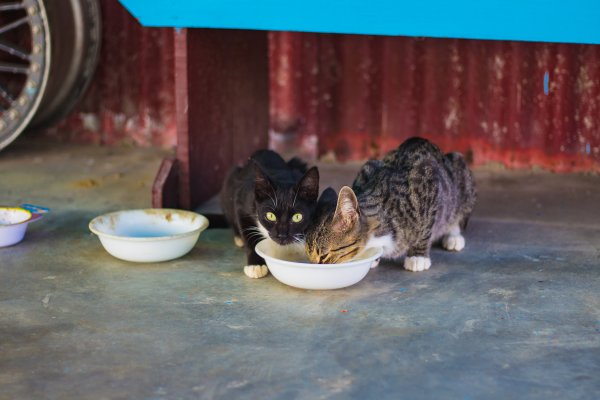Introducing Cats: A Guide for Your Expanding Feline Family
 Introducing Cats: A Guide for Your Expanding Feline Family
thegearhunt.com
Introducing Cats: A Guide for Your Expanding Feline Family
thegearhunt.com
Cats are not creatures that are solitary, and many of them often benefit from having other feline companions. That being said, cats also tend to be territorial, so the process of introduction will require both patience and finesse. If you just throw them together with the mentality that they will just work it out, you will be putting a lot of stress on both of them and you are also taking the chance that one or both of them can be seriously injured. A hurried or incorrect introduction can mean that they become bitter enemies. Alternatively, if you introduce them correctly, they can become lifelong friends.
Cats on High Alert
You might know a few people who used the not very well thought out and old-fashioned method of just putting the two cats together before letting nature take over. Some people who do this might have had outcomes that were successful, but what was the cost? How much stress did these introductions cause? Also, did the cats become friendly toward each other or just divide up the territory? Just because their owners didn’t notice any aggression, that doesn’t mean that the cats aren’t dealing with stressful conditions. This method of introducing cats is not recommended due to the risks it poses. It is also inhumane and, most of the time, ineffective. Why would anyone want to use this technique that will put every cat involved at risk?
Introduce Cats the Right Way
The way you should introduce new cats is to do it one sense at a time. The cats might first hear each other if they are both vocal. Then, they will catch each other’s scent. This should be done with a method of behavior modification. Then, they will see each other in a controlled situation. Finally, they will touch each other – this should be done in a positive and controlled manner. When it comes to tasting, one cat might lick the other or not. Hopefully, this aspect will not also involve biting.
The proper technique for introducing new cats needs to address both the physical and emotional needs of both of the animals. From the cat’s perspective who already lives with you, there is an intruder who is encroaching on his territory. From the point of view of the new cat, he has just been placed in hostile territory. Each of the cats need to have a feeling of security. If they feel like there isn’t any safe space for them, that is when they will go into survival mode and you will get spraying, fighting, and panic. However, if they feel like they can each remain in their own comfort zones while they check the situation out, you will typically be able to keep a handle on the panic situation. Each cat needs a safe area in which to decompress during this event that is life-changing for them. The cat already in residence will not understand why his territory is no longer just his and the new cat needs to acclimate himself to a new cat, unfamiliar humans, and unfamiliar territory. That is a lot of stress!
Step 1: A Sanctuary Room
 Set up a single room in your home that will be used as a safe space for the new cat. This will give him time to get a bit more familiar with his new surroundings in a way that gives him a bit of security. It is stressful as it is for a cat to move into an environment that isn’t familiar, so before they are introduced to the resident cat, allow him to get his bearings and have a bit of time to himself in the sanctuary room. You shouldn’t even try to attempt an introduction with a new cat who is reactive, so this room will give him a space in which to get back to normal. The more relaxed the cats are, the better the chances will be for an introduction that is successful.
Set up a single room in your home that will be used as a safe space for the new cat. This will give him time to get a bit more familiar with his new surroundings in a way that gives him a bit of security. It is stressful as it is for a cat to move into an environment that isn’t familiar, so before they are introduced to the resident cat, allow him to get his bearings and have a bit of time to himself in the sanctuary room. You shouldn’t even try to attempt an introduction with a new cat who is reactive, so this room will give him a space in which to get back to normal. The more relaxed the cats are, the better the chances will be for an introduction that is successful.
This sanctuary room might be any room that is able to be closed off. It needs to have some toys, a scratching post, a few places to hide, food and water, and a litter box. If you use a cat carrier to bring the creature into your home, leave that carrier in the sanctuary room with the door left open so that the animal can remain in there if he wants before heading out to explore the room. If your new cat happens to be fearful or timid, the ability to remain in the carrier that contains his own scent might give him some much-needed comfort.
For fearful cats, you might set up a few paper bag tunnels for him to use as a safe way for him to get to his food and water. This way, he can get to the litter box or food and water bowls while not feeling overly exposed. Put a few other hiding places for him in different areas of the room – like boxes you have cut a hole in and turned upside down. This might assist with them feeling as if he doesn’t need to remain hidden in your closet or cowering under the bed. Without these things, he might be too reactive and frightened, and this can leave you with an extremely stressful and unsuccessful introduction.
I Know Where You Are!
Even when your resident feline can’t see the new cat, he will know that they are just on the other side of the door. This is to be expected. However, by having the new feline in the sanctuary room, you are letting your resident feline know that only a small part of his territory is at risk and not his entire home.
Step 2: Mealtime – Time to Train the Cats
 The trick to introducing cats successfully lies in giving them a reason for liking each other. You can’t simply keep them separated for a while and then open the door and expect them to instantly bond. They will need to see good things occur when they are in each other’s presence, and later, even within sight of each other. An ideal way to do this is to use treats and food. Food can be a powerful motivator.
The trick to introducing cats successfully lies in giving them a reason for liking each other. You can’t simply keep them separated for a while and then open the door and expect them to instantly bond. They will need to see good things occur when they are in each other’s presence, and later, even within sight of each other. An ideal way to do this is to use treats and food. Food can be a powerful motivator.
Feed your felines by placing a food bowl on each side of the door to the sanctuary room. How far it needs to be from the actual door will depend on the reactivity of the cat. If the resident feline refuses to go closer than 6 feet from the door, then put it in his comfort zone. The next time you feed them, move the bowl a bit closer to the door.
If one of the cats eats more quickly than the other one, you might give the faster one a bowl that has a few obstacles – like a brake bowl for dogs. You might also press the food against the sides and bottom of the bowl instead of just piling it in the center, so that the cat will have to spend a bit more time getting it. Don’t offer too much food during these sessions. It will be better if you have frequent feedings at first, and make them short, so that they will end on a positive note.
Step 3: The Nose Talks
 You will need a pair of clean socks for this. Put a clean sock on your hand and then gently rub the new cat on his face in order to get facial pheromones on the sock. Pheromones are simply scent chemicals that are released by the scent glands of the cat. The ones around his face – on the forehead, cheeks, chin, and the sides of his mouth – are essentially friendly pheromones. Cats will rub their faces on things that make them feel comfortable. Therefore, by using a sock, you will create a fake cat that has quite a bit of friendly pheromones. Take this sock and allow the resident cat to play with it and get used to the scent of the new cat.
You will need a pair of clean socks for this. Put a clean sock on your hand and then gently rub the new cat on his face in order to get facial pheromones on the sock. Pheromones are simply scent chemicals that are released by the scent glands of the cat. The ones around his face – on the forehead, cheeks, chin, and the sides of his mouth – are essentially friendly pheromones. Cats will rub their faces on things that make them feel comfortable. Therefore, by using a sock, you will create a fake cat that has quite a bit of friendly pheromones. Take this sock and allow the resident cat to play with it and get used to the scent of the new cat.
Step 4: Open the Door
 When should you move to this step? That will be determined by your situation. There isn’t any sort of set time limit for how long you need to stay in one phase before going on to the next. If the cats aren’t yet comfortable enough with eating right on opposite sides of the door while it is cracked open, you will know that it isn’t time to move on to having the door open all the way. Introducing cats is a process that shouldn’t be rushed. Go slowly with each step and watch the reactions of your cats in order to decide when it will be time to move to the next step.
When should you move to this step? That will be determined by your situation. There isn’t any sort of set time limit for how long you need to stay in one phase before going on to the next. If the cats aren’t yet comfortable enough with eating right on opposite sides of the door while it is cracked open, you will know that it isn’t time to move on to having the door open all the way. Introducing cats is a process that shouldn’t be rushed. Go slowly with each step and watch the reactions of your cats in order to decide when it will be time to move to the next step.
When it comes to the time when you are going to open the door to the sanctuary room, and you are worried that one of the cats might rush through it, or if they have already tried it, you might want to take an interim step that will be putting a few baby gates across the doorway or by installing a temporary screen using pet screening. This will give the cats the ability to be within view of each other while keeping them from charging at each other. When feeding time is over, just close the door to the sanctuary room again. If you are standing by the door to the room during feeding time, you might even be able to get away with no baby gate or screening at all. With the baby gate, even though your cats will not have any trouble leaping over it, it can be an actual psychological barrier – one that is just enough to relax them so that they will be comfortable enough to eat.
Keep on with these feeding sessions where the cats can see each other while they are getting treats or eating. Increase the time of exposure gradually.
Final Step: Environment
 Set up the cats’ environment in such a way that it encourages security, plenty of territory for both of them, and fun. This will be critical when the cats begin to spend more time together and aren’t separated anymore. Use things like hideaways, perches, and cat trees in order to create different levels. If you increase the amount of territory that is elevated in their environment, you will also be greatly increasing the animals’ perception of the actual amount of territory that they have. This vertical territory also assists in making them feel safer because they know that they won’t be able to be ambushed from behind and they will have more visual ability to keep their environment under surveillance. Also, some cats actually use vertical territory in order to display their status and this can help with the avoidance of a physical confrontation.
Set up the cats’ environment in such a way that it encourages security, plenty of territory for both of them, and fun. This will be critical when the cats begin to spend more time together and aren’t separated anymore. Use things like hideaways, perches, and cat trees in order to create different levels. If you increase the amount of territory that is elevated in their environment, you will also be greatly increasing the animals’ perception of the actual amount of territory that they have. This vertical territory also assists in making them feel safer because they know that they won’t be able to be ambushed from behind and they will have more visual ability to keep their environment under surveillance. Also, some cats actually use vertical territory in order to display their status and this can help with the avoidance of a physical confrontation.
You might also want to increase the enrichment of the environment in order to give your felines a way to keep their attention diverted, to release extra energy, and to enjoy themselves. To do this, you might set up toys that dispense food, puzzle toys, and a few other opportunities for playtime that can be solo. Cat shelves for climbing, a bird feeder outside a window, and other such things might work to both divert their attention and ease some of the tension.
Have more than a single litter box as well as more than a single scratching post in the cats’ environment. These scratching posts and litter boxes should be in separate rooms so that they won’t need to cross each other’s path. Put critical resource items in each cat’s preferred area. This can give them more choice and can also help with them co-existing peacefully.
Continue with the mealtime training with the cats eating in the presence of each other but remember that they might never be comfortable enough to eat from the same bowl. It will be a good idea to keep feeding them with separate bowls because it will get them trained for the possibility of even more new cats in the future, or for one of them needing to be on a special diet.
Don’t Rush It
It is always advisable to remain at the pace of the cat who is the most stressed. One of the cats might be ready and willing to meet the other one, but if the other cat isn’t, you need to continue at the pace of the one who isn’t happy.
Introductions between new cats can take a bit of time, but it will be worth it to increase the odds of the two cats developing a healthy relationship.
Sources
- YouTube, How to Introduce Cats
- Last Hope, How to Introduce Your New Cat to Other Cats
- Jackson Galaxy, How to Introduce Two Cats
- Best Friends, Introducing a New Cat















